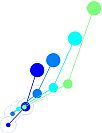In neuroscience, a major challenge is to disentangle the potentially distinct functions of brain regions supporting adaptive behavior. For instance, the dorsal striatum (dStr) is thought to contribute both to high-level functions like procedural memory or action selection and to “lower”-level functions such as movement kinematics control (vigor). Typically such functions overlap, as animals' movement patterns, motivation, and procedural learning co-vary. To address this challenge, we developed the "4 Towers Task," a novel behavioral paradigm that combines self-paced exploration/exploitation with controlled reward delivery to encourage flexible procedural learning. In this task, mice navigate an open arena containing four reward-dispensing towers, where reward contingencies can be modulated to control both local (per-tower) and global reward dynamics. We found that mice quickly learn procedural foraging rules and readily adapt to shifts in reward contingencies, adjusting foraging trajectories and maximizing reward rates. To investigate the role of striatal circuits in this behavior, we performed unilateral chemogenetic perturbations of striato-pallidal and striato-nigral pathways within the dStr while mice must adapt to changes in procedural rules. Preliminary results suggest that perturbing each pathway leads to reduced movement speed while sparing the mice ability to adapt to changes in procedural rules. These results suggest a “low”-level kinematic function of the dStr that constrains the execution of learned foraging skills to maximize the capture of rewards. More generally, the 4 Towers Task provides a robust framework for investigating the mechanisms underlying adaptive decision-making and motor control in a naturalistic behavior.
Recherche par auteur > Amroune KenzaHigh or low level function of striatum? Insights from unilateral perturbations in a new naturalistic foraging task for freely moving mice.
1 : Institut de Neurobiologie de la Méditerranée [Aix-Marseille Université]
Institut National de la Santé et de la Recherche Médicale - INSERM
2 : Institut de Neurobiologie de la Méditerranée [Aix-Marseille Université]
Institut National de la Santé et de la Recherche Médicale - INSERM
3 : Institut de Neurobiologie de la Méditerranée [Aix-Marseille Université]
CENTURI
4 : Institut de Recherche sur les Phénomènes Hors Equilibre
CENTURI
5 : Institut de Neurobiologie de la Méditerranée [Aix-Marseille Université]
CENTURI
|

 PDF version
PDF version
